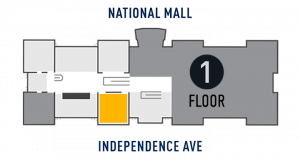The Wrights combined their wing-warping control concept and the structural design of the Chanute-Herring glider in their first aircraft, a biplane kite with a 5-foot wingspan, built in July 1899.
To allow for wing-warping, they left the kite unbraced between the front and rear struts (vertical posts). It was controlled with four lines running from the top and bottom of the front outer struts to a pair of sticks held by the operator. Tilting the sticks in opposite directions caused the wing structure to twist.
No photographs exist of the 1899 kite; only a sketch of it illustrating wing-warping, drawn by Wilbur in 1912.
Display Status
This object is on display in Wright Brothers & The Invention of the Aerial Age at the National Air and Space Museum in Washington, DC.

Object Details
Type
CRAFT-Kites
Owner
Rick Young
Physical Description
A biplane kite with square upper and lower wings and canard.
Materials
Wood
Fabric
Inventory Number
I20031236002
Credit Line
On Loan from Rick Young, Richmond, VA
Data Source
National Air and Space Museum
Restrictions & Rights
Usage conditions apply
For more information, visit the Smithsonians Terms of Use.